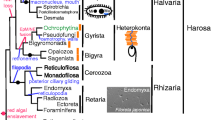Abstract
Unitary currents were recorded from insideout membrane patches pulled from Xenopus oocytes that had been injected with RNA transcribed from a cDNA encoding the Drosophila maxi-K channel (Slowpoke). Site-directed mutagenesis was used to make cDNAs encoding channel subunits with single amino acid substitutions (Y308V and C309P). The extracellular side of the patch was exposed to tetraethylammonium (TEA) in the pipette solution; unitary currents in the presence of TEA were compared with currents in the absence of TEA to compute the inhibition. Amplitude distributions were fit by β functions to estimate the blocking and unblocking rate constants. For wild-type channels, TEA blocked with an apparent K d of 80 μM at 0 mV and sensed 0.18 of the membrane electric field; the voltage dependence lay entirely in the blocking rate constant. TEA blocked currents through C309P channels with a similar affinity to wild-type at 0 mV, but this was not voltage-dependent. Currents through Y308V channels were very insensitive to any block by TEA; the apparent K d at 0 mV was 26 mM and the blockade sensed 0.18 of the electric field. Oocytes injected with a mixture of RNAs encoding wild-type and Y308V channels showed unitary currents of four discrete amplitudes in the presence of 3 mM TEA; at 40 mV these corresponded to inhibitions of approximately 80%, 55%, 25% and 10%. These values agreed well with those expected for inhibition by TEA of currents through channels containing 3, 2, 1 and 0 tyrosine residues at the channel mouth, assuming that a tyrosine residue from each of four subunits contributes equally to the binding of the TEA ion. This indicates that Slowpoke channels form as tetramers.
Similar content being viewed by others
References
Adams PR, Constanti A, Brown DA, Clark RB (1982) Intracellular Ca2+ activates a fast voltage-sensitive K+ current in vertebrate sympathetic neurones. Nature 296:746–748
Adelman JP, Shen K-Z, Kavanaugh MP, Warren RA, Wu Y-N, Lagrutta A, Bond CT, North RA (1992) Calcium-activated potassium channels expressed from cloned complementary DNAs. Neuron 9:209–216
Butler A, Tsunoda S, McCobb DP, Wei A, Salkoff L (1993) mSlo, a complex mouse gene encoding maxi calcium-activated potassium channels. Science 261:221–224
Dawson RMC, Elliott DC, Elliot WH, Jones KM (eds) (1969) Data for biochemical research. Oxford University Press, New York
Durell SR, Guy HR (1992) Atomic scale structure and functional models of voltage-gated potassium channels. Biophys J 62:243–252
Guy HR, Conti F (1990) Pursuing the structure and function of voltage-gated channels. Trends Neurosci 13:201–206
Haylett DG, Jenkinson DH (1990) Calcium-activated potassium channels. In: Cook NS (ed) Potassium channels: structure, classification, function and therapeutic potential. Ellis Horwood, Chichester, pp 70–95
Heginbotham L, MacKinnon R (1992) The aromatic binding site for tetraethylammonium ions on potassium channels. Neuron 8:483–491
Hille B (1967) The selective inhibition of delayed potassium currents in nerve by tetraethylammonium ion. J Gen Physiol 50:1287–1302
Hurst RS, Kavanaugh MP, Yakel Y, Adelman JP, North RA (1992) Cooperative interactions among subunits of a voltagedependent potassium channel: evidence from expression of concatenated cDNAs. J Biol Chem 267:23742–23745
Jan LY, Jan YN (1992) Tracing the roots of ion channels. Cell 69:715–719
Kavanaugh MP, Varnum MD, Osborne PB, Christie MJ, Busch AE, Adelman JP, North RA (1991) Interaction between tetraethylammonium and amino acid residues in the pore of cloned voltage-dependent potassium channels. J Biol Chem 266:7583–7587
Kavanaugh MP, Hurst RS, Yakel J, Varnum MD, Adelman JP, North RA (1992) Multiple subunits of a voltage-dependent potassium channel contribute to the binding site for tetraethylammonium. Neuron 8:493–497
Langton PD, Nelson MT, Huang Y, Standen NB (1991) Block of calcium-activated potassium channels in mammalian arterial myocytes by tetraethylammonium. Am J Physiol 260:H927-H934
Lorente de Nó, R (1949) On the effect of certain quaternary ammonium ions upon frog nerve. J Cell Comp Physiol [Suppl] 33:1–231
MacKinnon R, Yellen G (1990) Mutations affecting TEA blockade and ion permeation in voltage-activated K channels. Science 250:276–279
Newland CF, Adelman JP, Tempel BL, Almers W (1992) Repulsion between tetraethylammonium ions in cloned voltagegated potassium channels Neuron 8:975–982
Quayle JM, Standen NB, Stanfield PR (1988) The voltagedependent block of ATP-dependent potassium channels of frog skeletal muscle by caesium and barium ions. J Physiol (Lond) 405:677–698
Stanfield PR (1983) Tetraethylammonium ions and the potassium permeability of excitable cells. Rev Physiol Biochem Pharmacol 97:1–67
Taglialatela M, Van Dongen AMJ, Drewe JA, Joho RH, Brown AM, Kirsch GE (1991) Patterns of internal and external tetraethylammonium block in four homologous K+ channels. Mol Pharmacol 40:299–307
Villaroel A, Alvarez O, Oberhauser A, LaTorre R (1988) Probing a Ca2+-activated K+ channel with quaternary ammonium ions. Pflügers Arch. 413:118–126
Yellen G (1984) Ion permeation and blockade in Ca2+-activated K+ channels of bovine chromaffin cells. J Gen Physiol 84:157–186
Yellen G, Jurman ME, Abramson T, MacKinnon R (1991) Mutations affecting internal TEA blockade identify the probable pore-forming region of a K+ channel. Science 251:939–942
Author information
Authors and Affiliations
Rights and permissions
About this article
Cite this article
Shen, K.Z., Lagrutta, A., Davies, N.W. et al. Tetraethylammonium block of Slowpoke calcium-activated potassium channels expressed in Xenopus oocytes: Evidence for tetrameric channel formation. Pflugers Arch. 426, 440–445 (1994). https://doi.org/10.1007/BF00388308
Received:
Revised:
Accepted:
Issue Date:
DOI: https://doi.org/10.1007/BF00388308




